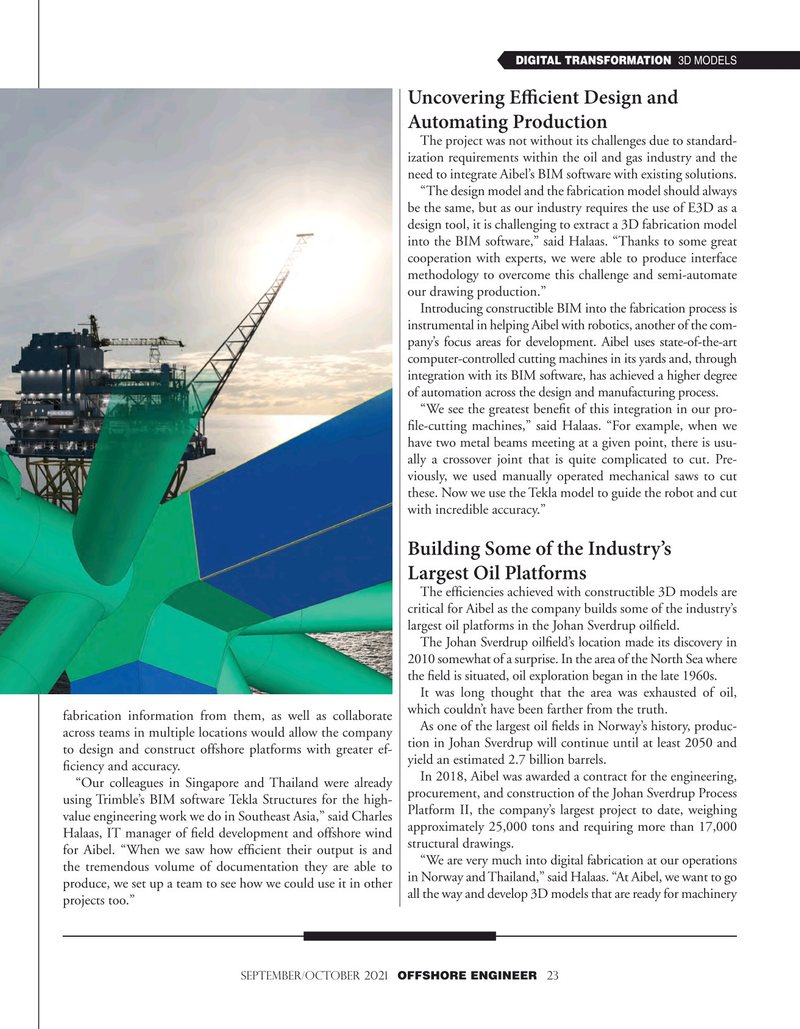
Page 23: of Offshore Engineer Magazine (Sep/Oct 2021)
Digital Transformation
Read this page in Pdf, Flash or Html5 edition of Sep/Oct 2021 Offshore Engineer Magazine
DIGITAL TRANSFORMATION 3D MODELS
Uncovering Efcient Design and
Automating Production
The project was not without its challenges due to standard- ization requirements within the oil and gas industry and the need to integrate Aibel’s BIM software with existing solutions. “The design model and the fabrication model should always be the same, but as our industry requires the use of E3D as a design tool, it is challenging to extract a 3D fabrication model into the BIM software,” said Halaas. “Thanks to some great cooperation with experts, we were able to produce interface methodology to overcome this challenge and semi-automate our drawing production.”
Introducing constructible BIM into the fabrication process is instrumental in helping Aibel with robotics, another of the com- pany’s focus areas for development. Aibel uses state-of-the-art computer-controlled cutting machines in its yards and, through integration with its BIM software, has achieved a higher degree of automation across the design and manufacturing process. “We see the greatest beneft of this integration in our pro- fle-cutting machines,” said Halaas. “For example, when we have two metal beams meeting at a given point, there is usu- ally a crossover joint that is quite complicated to cut. Pre- viously, we used manually operated mechanical saws to cut these. Now we use the Tekla model to guide the robot and cut with incredible accuracy.”
Building Some of the Industry’s
Largest Oil Platforms
The effciencies achieved with constructible 3D models are critical for Aibel as the company builds some of the industry’s largest oil platforms in the Johan Sverdrup oilfeld.
The Johan Sverdrup oilfeld’s location made its discovery in 2010 somewhat of a surprise. In the area of the North Sea where the feld is situated, oil exploration began in the late 1960s.
It was long thought that the area was exhausted of oil, fabrication information from them, as well as collaborate which couldn’t have been farther from the truth.
As one of the largest oil felds in Norway’s history, produc- across teams in multiple locations would allow the company tion in Johan Sverdrup will continue until at least 2050 and to design and construct offshore platforms with greater ef- yield an estimated 2.7 billion barrels. fciency and accuracy.
In 2018, Aibel was awarded a contract for the engineering, “Our colleagues in Singapore and Thailand were already procurement, and construction of the Johan Sverdrup Process using Trimble’s BIM software Tekla Structures for the high- value engineering work we do in Southeast Asia,” said Charles Platform II, the company’s largest project to date, weighing
Halaas, IT manager of feld development and offshore wind approximately 25,000 tons and requiring more than 17,000 for Aibel. “When we saw how effcient their output is and structural drawings. “We are very much into digital fabrication at our operations the tremendous volume of documentation they are able to produce, we set up a team to see how we could use it in other in Norway and Thailand,” said Halaas. “At Aibel, we want to go all the way and develop 3D models that are ready for machinery projects too.” september/october 2021 OFFSHORE ENGINEER 23

 22
22

 24
24